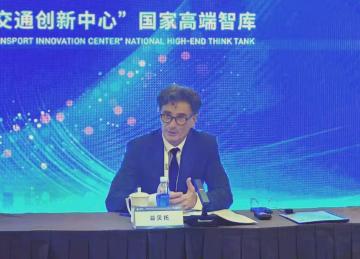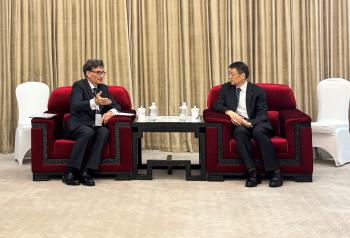How can we best support trade flows along the booming Trans-Caspian Corridor? The key lies in international conventions, the coupling of hard and soft infrastructure, and greater international cooperation, stressed IRU’s Secretary General at the International Symposium on China-Europe Trans-Caspian Direct Express in Beijing.
The Trans-Caspian Corridor, also known as the Middle Corridor, is now a critical trade route connecting China and Central Asia to the Caucasus and Europe.
Chinese transport companies are also increasingly using this route. Since the launch of the Trans-Caspian pilot by the Presidents of China and Kazakhstan in July 2024, Chinese operators have moved from pilot runs to regular commercial operations under the TIR system.
This includes the first shipment of lithium-ion batteries from China to Türkiye: a 7,000km journey completed in just three weeks, significantly faster than the 30 to 40 days typically required by sea.
These developments have diversified China-Europe trade routes and reinforced global supply chain resilience at a time when reliability is more crucial than ever.
But challenges are emerging. Congestion and long queues are becoming the norm, causing delays, higher costs, and putting significant pressure on drivers, operators and the environment.

IRU Secretary General Umberto de Pretto, speaking at the International Symposium on China-Europe Trans-Caspian Direct Express in Beijing, China, said, “To unlock the Trans-Caspian Corridor’s full potential, we first need to make better use of United Nations conventions such as TIR and CMR.
“TIR has been proven to reduce border transit times by up to 92%, lower transport costs by up to 50%, and cut CO₂ emissions in border crossing zones by up to 90%.
“Second, we need to strengthen hard infrastructure and soft connectivity. Even the best infrastructure cannot function effectively without robust soft connectivity. A key pillar of soft connectivity is international road transport agreements, which provide a legal basis for cooperation and reduce regulatory barriers.
“Third, we must deepen international exchange and cooperation. Cross-border transport is a multi-stakeholder ecosystem involving governments, associations, businesses and professionals across many countries.”
With freight volumes along the Trans-Caspian expected to double by 2030, Umberto de Pretto also underscored the importance of digitalisation and additional trade facilitation measures.
Tools such as eTIR, e-CMR, e-permits, and e-visas offer significant benefits in improving efficiency, enhancing security, and reducing environmental impact.
IRU has been working with its members and national authorities to promote the establishment of TIR Green Lanes (express lanes at borders for TIR movements). Central Asian countries and Mongolia have implemented TIR Green Lanes or Green Windows, which Umberto de Pretto encouraged other countries along the Trans-Caspian Corridor to adopt.
“The Trans-Caspian Corridor is more than a trade route. It is a strategic link for economic growth, regional integration and supply chain resilience. Let us work together, governments, international organisations, and the private sector, to remove barriers, embrace proven solutions, and make this corridor a global model of efficient connectivity,” concluded Umberto de Pretto.
Ministry of Transport talks
During his visit to Beijing, which also included a keynote address on strategic investment in transport, Umberto de Pretto held a series of bilateral discussions, including high-level talks with Li Yang, Vice Minister of China's Ministry of Transport, on TIR development in China and related corridors, sector growth, and international exchanges and cooperation.
Umberto de Pretto highlighted the impressive progress of TIR in China. IRU looks forward to further strengthening cooperation with China’s Ministry of Transport to support TIR development in the country and address the challenges faced by Chinese operators conducting international transport.

Li Yang reiterated the Ministry of Transport’s strong support to advance TIR development in China. He confirmed that the Ministry will support more Chinese transport companies to become TIR operators and conduct operations along China-linked corridors.
TIR operations are now taking off from 44 border and inland cities across China, with over 60 routes connecting China with countries across the Eurasian continent. Between January and May 2025, TIR movements from China jumped 275% compared to the same period last year.
